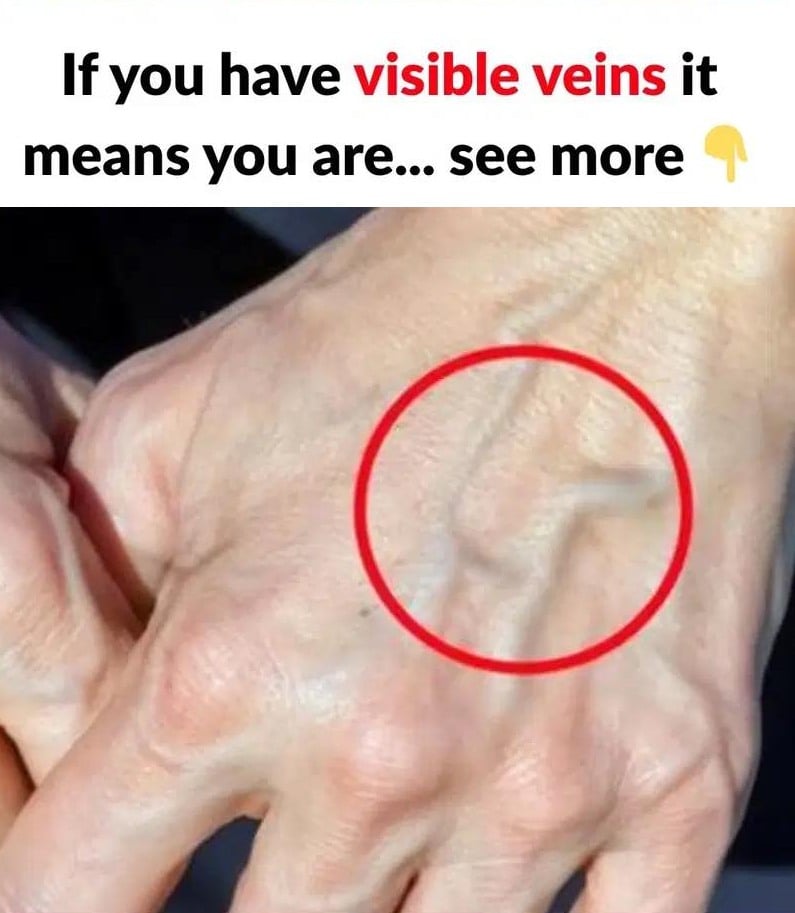In recent years, many people have noticed a curious phenomenon—suddenly seeing more prominent veins on their hands, arms, legs, or even their chest. These veins, once hidden beneath a layer of fat or skin, suddenly become more visible, often catching you off guard. For some, it’s a harmless, even normal, part of aging or a sign of changes related to body condition. But for others, these visible veins can be a cause for concern, signaling underlying health issues that shouldn’t be ignored. Understanding why veins become more prominent is important, not just from a cosmetic point of view, but also for recognizing potential health risks.
First, it’s essential to recognize that in many cases, visible veins are a natural part of life. They are often harmless and simply a reflection of the body’s natural aging process. As we grow older, our skin gradually loses its elasticity and becomes thinner. This thinning skin makes underlying structures, like veins, more apparent. This process happens to everyone to some extent over time, especially after middle age, when skin aging becomes more pronounced. For some, the veins are more prominent due to genetics; if your family members tend to have visible veins, there’s a higher chance you might notice them too.
One of the most common reasons veins become more visible is weight loss or a decrease in body fat. When we shed fat—whether through dieting, increased activity, or natural aging—the layer of fat that usually camouflages veins diminishes. In particular, limbs and the torso tend to reveal veins more clearly because they have a greater network of superficial blood vessels close to the surface. This is often seen in athletes or people who have undergone significant weight reduction. While this is generally benign, it’s a reminder that body fat acts like a natural cover, hiding and protecting blood vessels and other structures under the skin.
Exercise and weight training are other significant factors. During physical activity, blood flow increases dramatically as muscles demand more oxygen. This increased circulation causes veins to swell and become temporarily more prominent—often called “vascularity” among bodybuilders. With consistent strength training over time, muscles grow and push veins closer to the skin’s surface. This is often regarded as a sign of good fitness and muscle tone. While it’s usually a natural response, it can sometimes be mistaken for health problems, which underscores the importance of understanding the context of visible veins.
Temperature also plays a role in vein visibility. Warm weather makes veins more prominent because the body strives to cool itself. To do so, veins widen or dilate to allow more blood to flow close to the skin surface, where heat can be dissipated. This is a normal reaction—your arms and legs may look more “veiny” when it’s hot outside, and this usually isn’t a cause for alarm. Once the temperature drops, the veins typically contract and become less visible again.
Ageing is perhaps one of the most common reasons behind increased visibility of veins. As we get older, skin naturally becomes thinner and loses some of its elasticity. This process, combined with a reduction in collagen and fat padding, causes blood vessels to show through more clearly. Elderly people often notice their veins become more prominent over time, especially in the limbs, neck, or face. While part of aging is unavoidable, it’s important to be aware of other signs of circulatory or vascular health issues that might accompany prominent veins.
Hormonal changes can also trigger visible veins. During pregnancy, menopause, or hormone therapy, fluctuations in hormones like estrogen and progesterone influence blood circulation, vessel dilation, and blood vessel wall elasticity. These changes can sometimes cause veins to appear unexpectedly—especially in the legs, chest, or face—leading to concerns about varicose veins or other circulatory issues. In pregnancy, for example, increased blood volume and pressure on blood vessels often make veins more visible and may cause discomfort or swelling.
While these factors are often completely benign, in some cases, prominent veins can indicate underlying health issues that should be evaluated by a healthcare professional. Conditions like varicose veins, deep vein thrombosis (DVT), or vascular diseases can cause veins to enlarge and become more noticeable, sometimes accompanied by pain, swelling, or discoloration. If you notice additional symptoms alongside prominent veins—such as persistent swelling, tenderness, discoloration, or pain—it’s important to seek medical advice for proper diagnosis and treatment.
It’s also worth noting that in some cases, prominent veins may signal circulatory problems or issues related to blood pressure. For example, some conditions affect the strength and elasticity of blood vessel walls, leading to dilated veins that can be permanent or fluctuate with activity and temperature. People with certain medical conditions, such as heart or circulatory diseases, should be particularly vigilant about changes in their veins and overall circulation.
In summary, the appearance of new or more prominent veins isn’t always a cause for concern. Often, it’s a normal part of aging, physical activity, or hormonal fluctuations. But it’s crucial to stay informed about what these changes mean, and to pay attention to other symptoms




